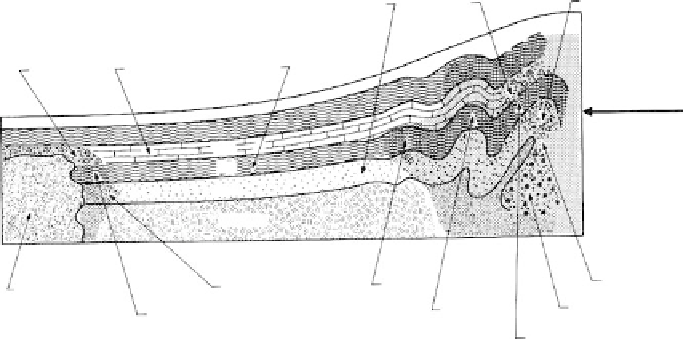Environmental Engineering Reference
In-Depth Information
5.2.5
Metamorphic Rocks
Origin
The constituents of igneous and sedimentary rocks are changed by metamorphism.
Metamorphism
Effects
Tremendous heat and pressure, in combination with the activity of water and gases, pro-
mote the recrystallization of rock masses, including the formation of minerals into larger
grains, the deformation and rotation of the constituent grains, and the chemical recombi-
nation and growth of new minerals, at times with the addition of new elements from the
circulating waters and gases.
Metamorphic Forms
Contact or thermal metamorphism
(Figure 5.4)
has a local effect, since heat from an intru-
sive body of magma causes it, recrystallizing the enveloping rock into a hard, massive
body. Away from the intrusive body, the effect diminishes rapidly.
Cataclastic metamorphism
(Figure 5.4) involves mountain building processes (orogenic
processes), which are manifestations of huge compressive forces in the Earth's crust that
produce tremendous shearing forces. These forces cause plastic flow, intense warping and
crushing of the rock mass, and, in combination with heat and water, bring about chemical
changes and produce new minerals.
Regional metamorphism
combines high temperatures with high stresses, during which the
rocks are substantially distorted and changed.
Classification
Classification is based primarily on fabric and texture as given in
Table 5.11.
Massive fabric
is homogeneous, often with equigranular texture.
Foliated fabric
is a banded or platy structure providing weakness planes that result from
high directional stresses, and include three forms:
Quartzite
Sandstone
Marble
Shale
Marble
Limestone
Cataclastic
metamorphism
(Compressive
force)
Ls
Sh
Ss
Granite
Schist
Contact
metamorphism
(intrusive
body)
Slate
Quartzite
Gneiss
Phyllite
Hornfels
Schist
FIGURE 5.4
Formation of metamorphic rocks from heat and pressure.



